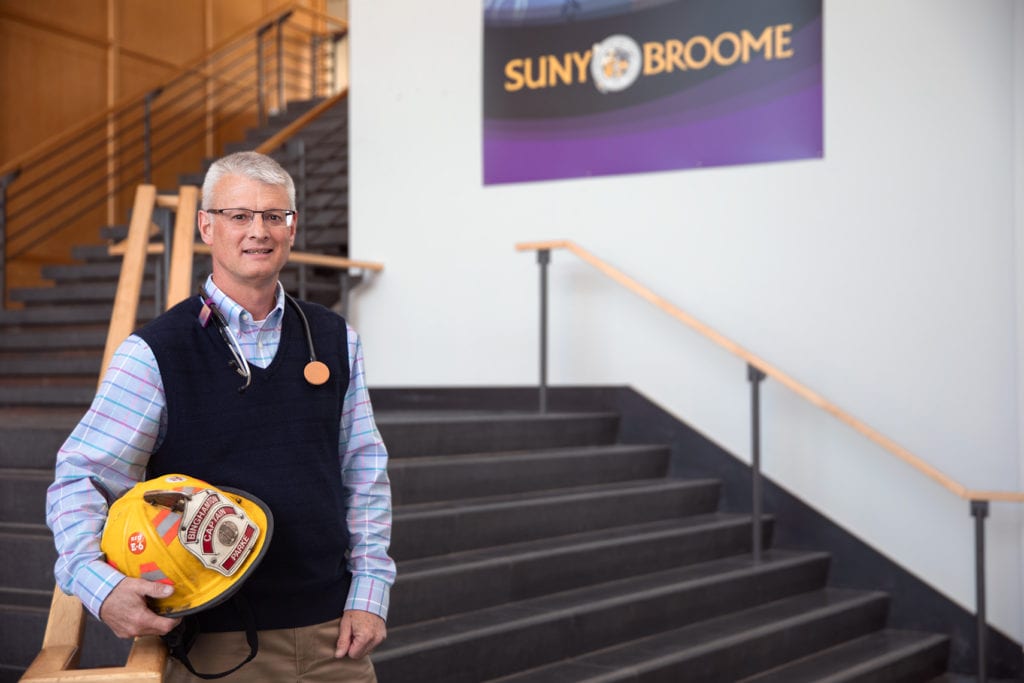
These days, Bob Parke isn’t pulling 24-hour shifts at the city fire station, ready to respond whenever disaster strikes. However, emergency services are still a part of his core identity – as both a volunteer firefighter with Five Mile Point and an instructor for the next generation of first responders.
The SUNY Broome alumnus enjoys teaching emergency management in SUNY Broome’s Department of Criminal Justice and Emergency Services, as well as the EMT program at Binghamton University’s Decker School of Nursing.
Through his years of teaching both at BU and SUNY Broome, Parke has met many of the county’s emergency services personnel. SUNY Broome Chemistry Professor Rob Congdon, for example, went through EMT training and is part of the county HazMat team.
“It feels good to have a hand in the people who protect our community,” he said. “Students need to learn about their options in the community. What better place than a community college?”
Learn about SUNY Broome’s Homeland Security degree program.
A lifestyle of learning
Giving back is a tradition in his family – perhaps dating all the way back to the Civil War.
“A way-back distance relative of ours worked directly with Clara Barton in the Civil War to notify loved ones of Union soldiers where they were buried in Andersonville, Georgia,” he said.
Closer in time, Parke’s grandmother volunteered at Lourdes Hospital for more than 40 years, and his father – who graduated from SUNY Broome with a business degree, was a critical care technician. His sister is a nurse practitioner who started her education at SUNY Broome, transferred to Binghamton University, and now works at Lourdes. His cousins are volunteer firefighters in New York and Pennsylvania.
The next generation has continued the trajectory of community care. His daughter, Emily Parke, graduated from SUNY Broome’s Nursing program in May 2019 and now works as a cardiology nurse in Rochester.
He was already volunteering at the local firehouse in 1978, when he made his first try at SUNY Broome after graduating from Chenango Valley High School. Then a Radiologic Technology major, he dropped out after only a year.
He worked as a professional photographer for a time, and continued to volunteer as a firefighter in Hillcrest and Port Dickinson. A mentor recommended that he join Binghamton’s professional department. He landed his dream job in 1992 and spent a rewarding 24-year career with the there.
“A chief once told me years ago: ‘When someone dials 911, it’s the worst day of their lives.’ You name it – if it doesn’t involve a cop, the fire department does everything else,” Parke said.
Unlike many states, New York doesn’t require firefighters to hold anything other than a high school diploma. Instead, the hiring process requires a national physical agility test, a civil service test, a psychological evaluation and approval by the fire chief and city mayor; after hiring, recruits undertake 20 weeks of training before they enter the field.
However, firefighters continue to pursue additional training and education on their own to expand their career opportunities, Parke among them. In essence, learning is part of the first-responder lifestyle, keeping up with new developments in tandem with changing technology.
One modern-day example: The lithium batteries found in some models of electric cars burn when exposed to water, Parke noted, a factor that shapes firefighters’ response.
Parke’s return to SUNY Broome in 1996 came in the wake of a different professional trend: Fire-based Paramedic ambulances were becoming more common, and Binghamton had the first in the county. Seeking to improve patient care, they sent members of the department for a semester-long paramedic training course. David Tinklepaugh, today the director of the Southern Tier Paramedic Program, was one of Parke’s lab instructor preceptors in the program.
Learn about SUNY Broome’s EMT/Paramedic degree and certificate programs.
He decided to return on his own for a pair of associate’s degrees: as an EMT/Paramedic in 2002 and in Fire Science in 2005. The Paramedic degree program goes beyond the basic life support covered in the initial training, he explained.
Learn about SUNY Broome’s degree program in Fire Protection Technology.
“In the paramedic program, you have a specialty in emergency medicine. There are things you do in a field setting that are different than what doctors and nurses do. The degree is very intensive and a full-time commitment,” he said.
He also ended up teaching EMT courses himself, both at SUNY Broome and at Binghamton University, training the student members of the university’s Harpur’s Ferry ambulance.
“I always ended up back here on campus,” he said.

From firefighting to Emergency management
As a Binghamton firefighter, Bob Parke was actively involved in emergency efforts during the region’s major 2006 and 2011 floods, wading through chest-deep water to rescue stranded residents. It inspired him to pursue emergency management as a way to mitigate such disasters – and, when possible, plan for their prevention.
In 2015, he went on to earn a bachelor’s degree in emergency management through SUNY Empire State College. SUNY Empire relies on distance learning, and Parke found that it aligned well with his work.
“We were working 24-hour shifts in the fire station. At 3 a.m., between calls I could log on and do homework,” he said.
Learn about your options through SUNY Broome’s Bachelor Partnership Center.
It also gave him the foundation he needed for the next chapter in his life, after he retired from the Binghamton Fire Department in 2016.
During his classes at SUNY Broome, he discusses real-life events, such as the floods and a natural gas truck crash that spurred the evacuation of a section of Hillcrest. Students consider what went right and wrong, the impact of the planning process, and the involvement of other agencies and organizations – from different levels of government to utilities and the state Department of Transportation.
Emergency management may officially be a county effort, but it’s never conducted solo – a lesson also driven home during the college’s annual Mock Environmental Disaster, which allows students in multiple programs to test their skills in the field.
Bob Parke has spent his career in helping Southern Tier residents on the worst days of their lives – and trying to prevent those days from happening at all. Teaching future responders is another way to shore up that safety net.
“What goes around comes around. At your local or your county level, you say, what can I contribute so that one day when I need help, the service is there?” he said.
Tags: Alumni, Business and Professional Studies Division, Criminal Justice and Emergency Services Department, Emergency Medical Technology - Paramedic AAS and Cert, Homeland Security & Emergency Management AS, Profile

